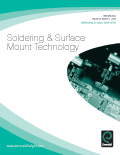
SOLDERING & SURFACE MOUNT TECHNOLOGY
Scope & Guideline
Transforming Research into Real-World Solutions
Introduction
Aims and Scopes
- Solder Joint Reliability:
The journal emphasizes research on solder joint reliability, including studies on thermal cycling, mechanical stress, and the effects of various solder materials on joint performance. - Materials Science and Engineering:
A core focus is on the development and characterization of new solder materials, including lead-free options and composite solders, addressing their mechanical, thermal, and electrical properties. - Advanced Soldering Techniques:
The journal covers innovative soldering techniques such as laser soldering, ultrasonic soldering, and 3D printing of solder materials, highlighting their applications in modern electronic packaging. - Microstructural Analysis:
Research on the microstructure of solder joints, including intermetallic compound formation and the effects of doping elements, is a significant area of interest, providing insights into joint performance. - Modeling and Simulation:
The use of numerical modeling and simulations to predict solder joint behavior under various conditions, including thermal and mechanical loads, is a prominent methodology employed in the journal. - Machine Learning Applications:
Emerging themes include the integration of machine learning techniques for optimizing soldering processes and predicting solder joint reliability, reflecting a modern approach to electronic manufacturing.
Trending and Emerging
- Lead-free Solder Research:
There is a significant increase in publications focusing on lead-free solder materials, driven by environmental regulations and the demand for sustainable electronics. - Nanomaterials and Composites:
Research on the incorporation of nanomaterials and composite solder systems is gaining traction, highlighting their potential to enhance mechanical properties and thermal performance. - Advanced Characterization Techniques:
Emerging trends include the use of advanced characterization techniques, such as nanoindentation and high-resolution imaging, to study solder joint microstructures and properties. - Thermal and Mechanical Reliability Studies:
An increasing number of papers are dedicated to the thermal and mechanical reliability of solder joints, particularly in high-performance applications, reflecting industry needs. - Artificial Intelligence and Machine Learning:
The application of artificial intelligence and machine learning for optimizing soldering processes and predicting joint reliability is rapidly emerging as a key area of research. - Integration of IoT in Soldering Processes:
The exploration of the Internet of Things (IoT) in monitoring and optimizing soldering processes is emerging, indicating a trend towards smarter manufacturing solutions.
Declining or Waning
- Traditional Lead-based Solders:
There seems to be a declining focus on traditional lead-based solder materials as the industry shifts towards lead-free alternatives, reflecting regulatory changes and environmental concerns. - Basic Soldering Techniques:
Research on basic soldering techniques has decreased, likely due to the industry's move towards more advanced methods and automation, which are now prioritized in newer studies. - Generalized Solder Joint Testing:
There is a noticeable reduction in studies that focus on generalized solder joint testing without specific applications or advanced methodologies, as the journal emphasizes more innovative and targeted research. - Historical Reviews:
The frequency of historical reviews on soldering practices and materials has diminished, suggesting that the journal is focusing more on cutting-edge research rather than retrospective analyses.
Similar Journals

International Journal of Surface Science and Engineering
Fostering Excellence in Surface and Coating ResearchThe International Journal of Surface Science and Engineering, published by INDERSCIENCE ENTERPRISES LTD, serves as a vital platform for researchers and professionals in the field of mechanical engineering, surfaces, coatings, and materials science. With an ISSN of 1749-785X and an E-ISSN of 1749-7868, this journal disseminates innovative research addressing the challenges and advancements in surface technologies and engineering practices. Its scope includes, but is not limited to, surface coatings, interface properties, and novel material applications. Since its inception in 2007, the journal has established a solid reputation, achieving a Q3 ranking in Mechanical Engineering and Surfaces, Coatings and Films, and a Q4 ranking in Surfaces and Interfaces as of 2023. These metrics underscore the journal's growing influence, despite being positioned within the Q3 and Q4 quartiles of its categories. The International Journal of Surface Science and Engineering provides a curated collection of high-quality articles that contribute significantly to the understanding of surface phenomena, fostering collaboration and advancements in the field. Researchers, professionals, and students alike will find this journal an indispensable resource for cutting-edge developments and in-depth analyses.
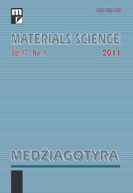
Materials Science-Medziagotyra
Advancing the Frontiers of Materials ScienceMaterials Science-Medziagotyra is a prominent peer-reviewed journal dedicated to the field of materials science, published by Kaunas University of Technology in Lithuania. Since its transition to an Open Access model in 2012, it has facilitated broad dissemination of research findings, enhancing accessibility for researchers and professionals worldwide. This journal is indexed in Scopus and has consistently contributed to the academic community with a focus on innovative materials and their applications, ranking in the Q3 category of Materials Science (miscellaneous) as of 2023. With the responsibility of synthesizing substantial research from 2008 through 2024, Materials Science-Medziagotyra aims to bridge gaps in material research while fostering collaboration among scientists, students, and industry leaders. Its commitment to quality and rigor in scientific discourse underscores its relevance and importance in advancing the field.

Materials Physics and Mechanics
Bridging Physics and Engineering for Material AdvancementMaterials Physics and Mechanics is a pivotal journal dedicated to advancing the fields of condensed matter physics, materials science, mechanical engineering, and the mechanics of materials. Published by the Institute of Problems in Mechanical Engineering, Russian Academy of Sciences, this journal has established itself as a valuable resource since its inception, particularly from 2003 to 2004 and now continuously from 2009 to 2024. Although it currently holds a Q4 categorization in various disciplines, its contributions are critical to understanding and developing new materials and their applications in engineering. The journal provides insightful articles that explore the nuances of material properties, their behaviors under different conditions, and the physical principles governing these phenomena. Though it operates under a traditional publication model, the insights provided within its pages are invaluable to researchers, professionals, and students striving to push the boundaries of knowledge in the materials domain. Its ISSN numbers (1605-2730, E-ISSN 1605-8119) serve as a gateway to a wealth of scientific knowledge emanating from the Russian Federation, contributing to the global discourse in materials physics and mechanics.

World Journal of Engineering
Exploring New Frontiers in Engineering ResearchWorld Journal of Engineering, published by EMERALD GROUP PUBLISHING LTD, stands as a premier platform for disseminating high-quality research across various engineering disciplines. Since its inception in 2014, the journal has built a reputation for its rigorous peer-review process and commitment to advancing knowledge in the fields of Civil and Structural Engineering, Electrical and Electronic Engineering, Geotechnical Engineering, Mechanical Engineering, and Mechanics of Materials. With its categorization in the Q3 quartile across multiple engineering domains and notable Scopus rankings, the journal positions itself as a valuable resource for researchers, professionals, and students seeking to stay abreast of innovations and critical developments in engineering. While the journal currently operates under a subscription model, its comprehensive scope ensures that it remains a vital reference point for contemporary engineering challenges and solutions throughout the United Kingdom and beyond.
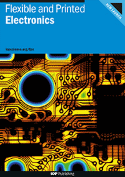
Flexible and Printed Electronics
Transforming Ideas into Electronic SolutionsFlexible and Printed Electronics, published by IOP Publishing Ltd, is a leading journal dedicated to advancing the field of flexible and printed materials within the realm of electrical and electronic engineering. With an impressive Q2 ranking in both Electrical and Electronic Engineering and Electronic, Optical, and Magnetic Materials, this journal is recognized for its significant contributions to the understanding and application of innovative electronic devices and systems. Covering a wide array of topics from materials science to engineering applications, it serves as a vital resource for researchers, professionals, and students alike. The journal's rigorous peer-review process and commitment to high-quality publications ensure that readers are exposed to cutting-edge research and developments. Submissions are welcomed from global contributors, providing a platform for the dissemination of groundbreaking ideas and technologies. With its impressive impact in the academic community, Flexible and Printed Electronics is poised to influence the future of electronics and materials technology.

Advances in Materials Research-An International Journal
Exploring the Frontiers of Materials ScienceAdvances in Materials Research - An International Journal is an esteemed publication in the field of materials science, spearheaded by TECHNO-PRESS. Established to provide a critical platform for the dissemination of high-quality research, this journal focuses on a broad spectrum of topics, including Biomaterials, Ceramics, Composites, Electronic, Optical, Magnetic Materials, Metals, Alloys, and Polymers. With a commendable impact factor reflecting its substantial contribution to the scientific community, Advances in Materials Research promotes innovative ideas through rigorous peer-review processes and supports the continuous advancement of materials research, particularly in the dynamic environment of South Korea. This journal, which holds impressive rankings across various subfields in the Scopus database, is designed to cater to the needs of researchers, professionals, and students aiming to stay at the cutting edge of materials science. By bridging gaps between theory and application, it invites contributions that push the boundaries of knowledge and technology in diverse material applications.
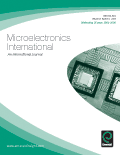
MICROELECTRONICS INTERNATIONAL
Shaping tomorrow's technology with today's research.MICROELECTRONICS INTERNATIONAL is a distinguished peer-reviewed journal published by Emerald Group Publishing Ltd, focusing on the expansive domains of microelectronics, materials science, and physics. With its ISSN 1356-5362 and E-ISSN 1758-812X, the journal has been a critical platform for researchers since its inception in 1982. Although it currently holds a Q4 category ranking across multiple disciplines such as Atomic and Molecular Physics, Electronic Engineering, and Surfaces, Coatings and Films, it remains committed to advancing scholarship and fostering dialogue within these fields. The journal's scope encompasses innovative research and developments that contribute to the understanding and technological evolution of microelectronic materials and systems. While it doesn't offer open access, its content is accessible through various academic databases, enabling a broad audience of professionals and enthusiasts to engage with high-quality research findings. As microelectronics continues to play a pivotal role in shaping modern technology, MICROELECTRONICS INTERNATIONAL serves as an essential resource for advancing knowledge and inspiring future innovations.
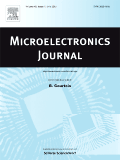
MICROELECTRONICS JOURNAL
Connecting Researchers with Cutting-Edge Microelectronics KnowledgeMICROELECTRONICS JOURNAL, published by Elsevier Sci Ltd since 1974, serves as a pivotal platform for disseminating cutting-edge research in the realms of microelectronics, nanotechnology, and materials science. With editions spanning from 1974 to 2024, the journal is well-respected within the scientific community, boasting a strong presence in key categories such as Atomic and Molecular Physics, Condensed Matter Physics, and Electrical and Electronic Engineering, as evidenced by its Q3 ranking in 2023. Researchers and professionals engaged in the exploration of electronic materials, optical applications, and nanoscale innovations can greatly benefit from the journal's insights, which situate their work within a robust academic framework. Although the journal does not currently offer open access, its rigorous peer-review process and high visibility in Scopus rankings—including a percentile ranking of 58th in Condensed Matter Physics—make it an essential resource for anyone looking to stay at the forefront of advancements in microelectronics and related fields.

Applied Science and Convergence Technology
Bridging Disciplines for a Technological TomorrowApplied Science and Convergence Technology (ISSN: 2288-6559) is a premier academic journal published by the Korean Vacuum Society, dedicated to advancing knowledge in the intersecting fields of condensed matter physics, electrical and electronic engineering, materials science, and theoretical chemistry. Based in South Korea, this journal serves as an essential platform for researchers, professionals, and students seeking to explore innovative applications and methodologies that drive convergence in science and technology. With a convergence period spanning from 2019 to 2024, the journal aims to publish high-quality original research and review articles that foster collaboration and knowledge sharing across disciplines. Its current quartiles position in top categories, alongside a respectable rank in Scopus, highlights its significance within the scientific community, although it is presently classified within lower tiers. The journal's commitment to open access ensures that vital research findings are accessible to a global audience, facilitating advancements in science and technology. As a notable outlet in its field, Applied Science and Convergence Technology continues to attract contributions that not only challenge current paradigms but also pave the way for future innovations.
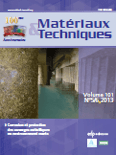
Materiaux & Techniques
Your Gateway to the Latest in Material Science ResearchMateriaux & Techniques, published by EDP SCIENCES S A, is a prominent journal in the field of materials science, specifically focusing on diverse and innovative techniques in material development and application. With an ISSN of 0032-6895 and an E-ISSN of 1778-3771, this French journal serves as a key resource for researchers and professionals looking to advance their knowledge and share their findings within the community. The journal holds a Q3 ranking in Materials Science (miscellaneous), indicating its role in contributing to various facets of material science research amidst a growing field. Despite operating under a traditional access model, it provides a platform for rigorous peer-reviewed studies and significant advancements in material technology. With a publication history tracing back to the late 1970s and extending through to 2024, Materiaux & Techniques continues to uphold its commitment to fostering high-quality discourse and innovation in materials science.